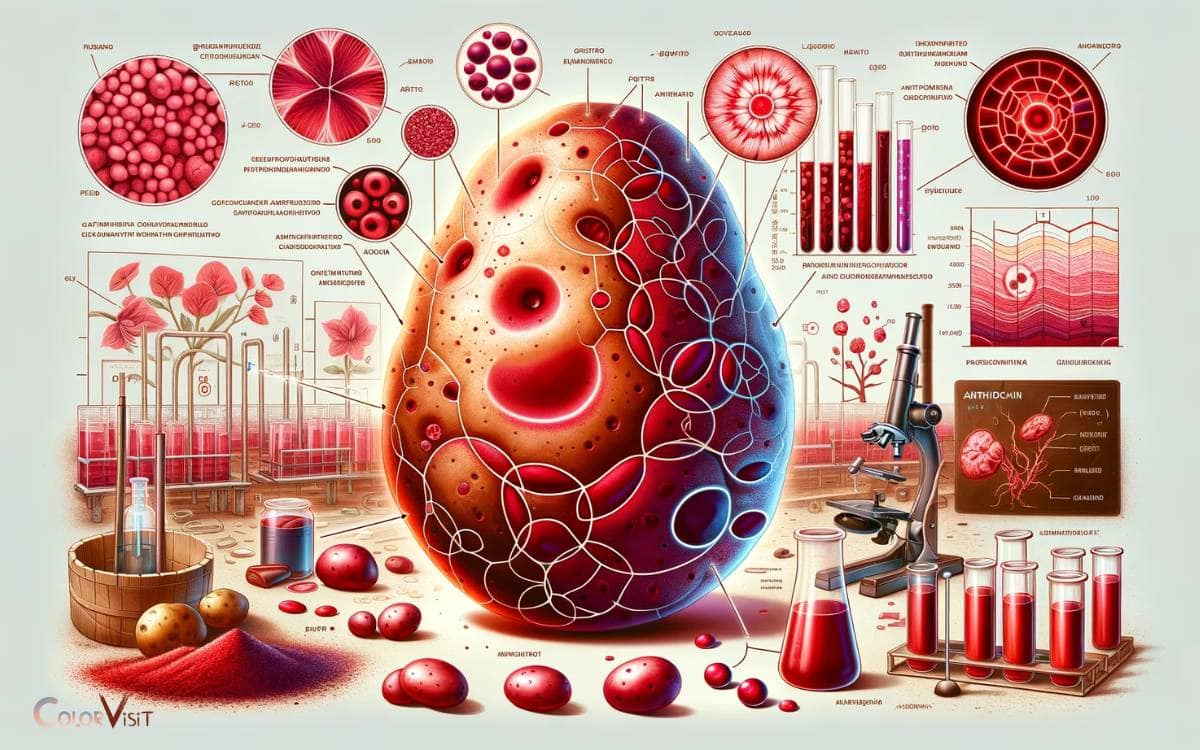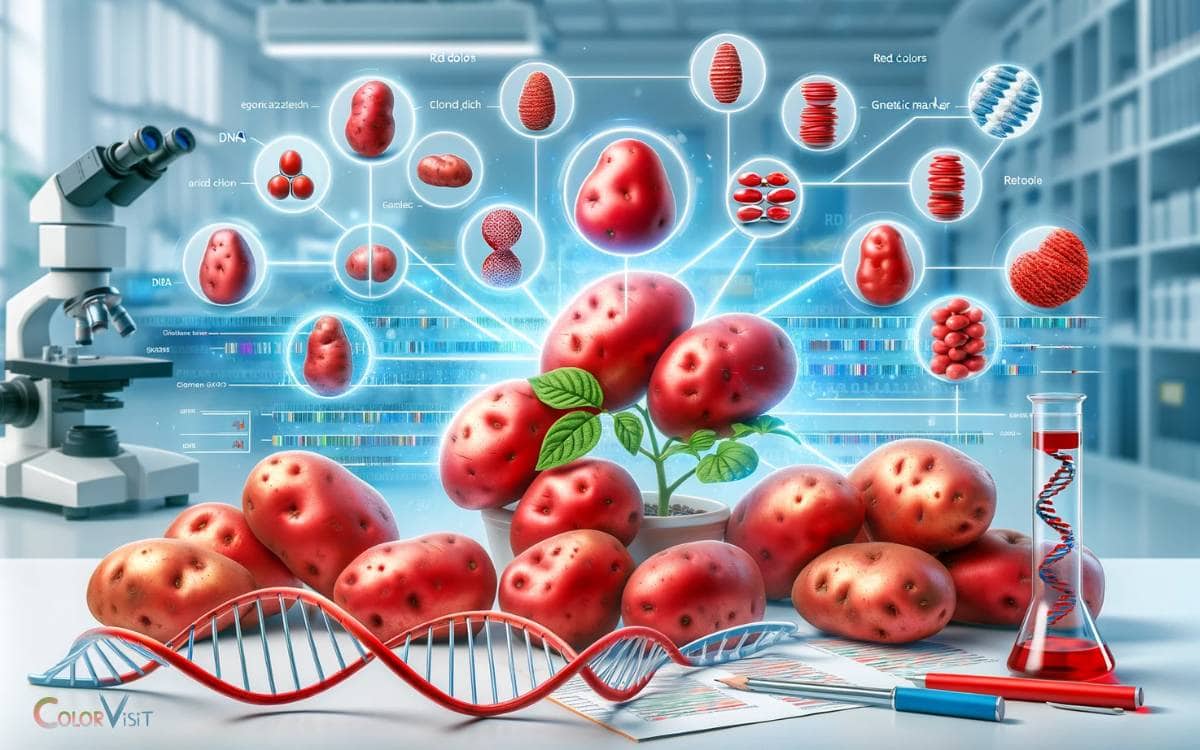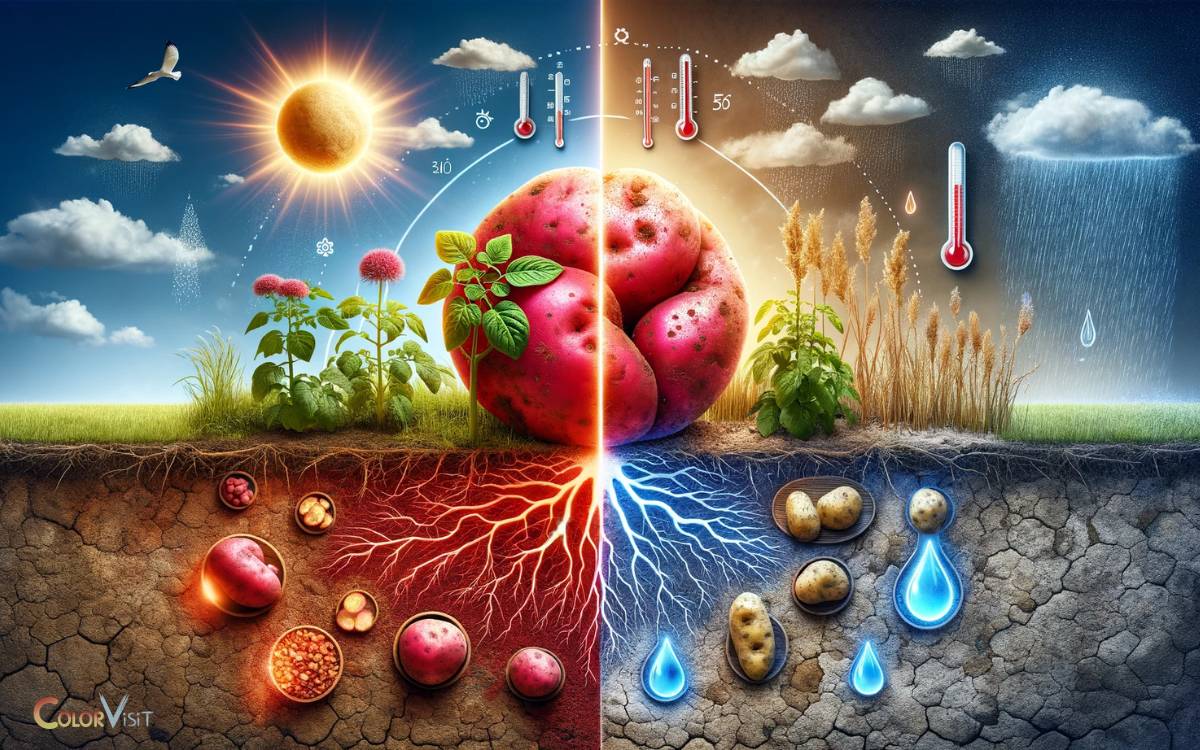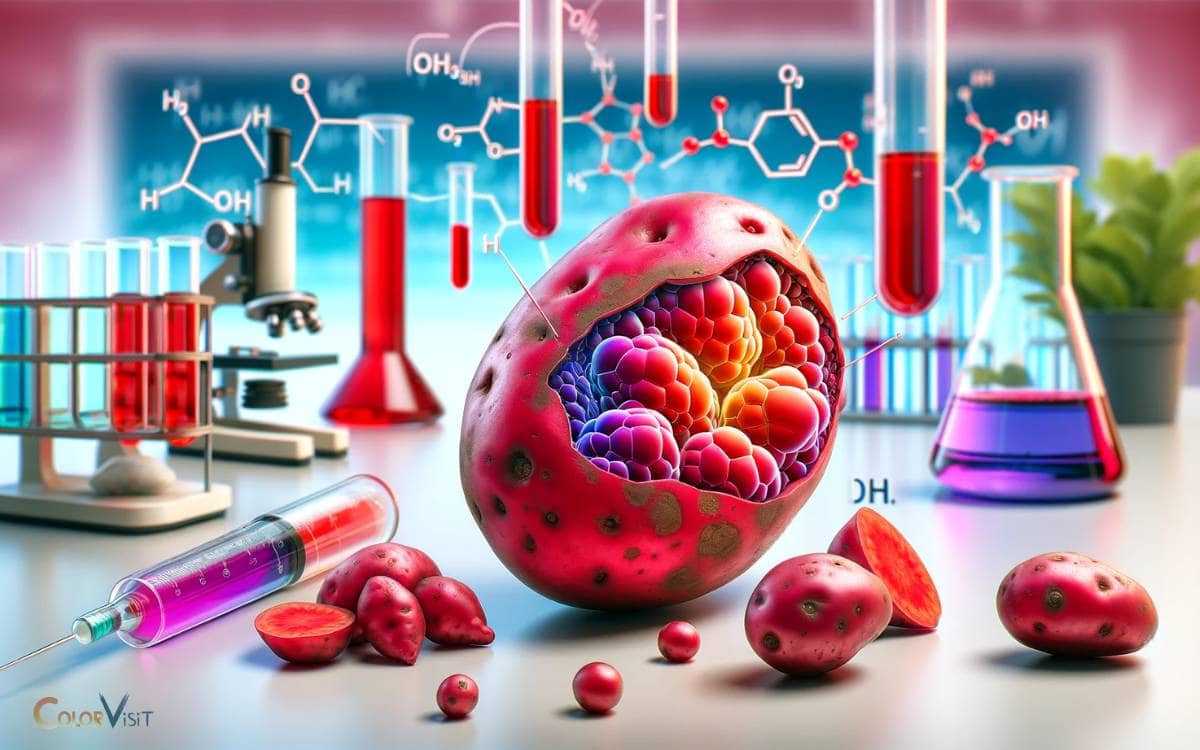How Do Red Potatoes Get Their Color? Anthocyanin!
Red Potatoes get their color from a pigment called anthocyanin. This pigment, influenced by genetic and environmental factors, along with harvesting, storage, and cultivation practices, contributes to the vibrant red hue of these potatoes.
Anthocyanin, a powerful antioxidant, is responsible for the red color in red potatoes. It is a pigment that is influenced by both genetic factors within the potato itself and environmental conditions, such as soil type, temperature, and sunlight exposure.
For instance, a red potato grown in richer, darker soil may have a deeper red color than one grown in lighter soil.
In essence, the captivating red hue of these potatoes isn’t just appealing to the eye. It signifies the presence of anthocyanin, a beneficial antioxidant, influenced by several factors from genes to environment and cultivation practices.
Key Takeaway
The Science of Red Potato Pigments
The red color of red potatoes is primarily attributed to the presence of specific pigments in their flesh and skin.
- These pigments, known as anthocyanins, are water-soluble and belong to the flavonoid group of compounds.
- The development of red color in potatoes involves complex chemical reactions within the plant cells.
- Anthocyanins are synthesized through the phenylpropanoid pathway, where enzymes catalyze the conversion of phenylalanine to various intermediates, ultimately leading to the production of anthocyanins.
- The color development is influenced by factors such as pH, temperature, and light exposure.
- Understanding the chemical reactions and processes involved in the synthesis and accumulation of anthocyanins is crucial for enhancing the red color in potatoes through innovative agricultural techniques and breeding strategies.
- This knowledge can pave the way for developing potatoes with intensified red pigmentation and increased nutritional value.
Genetic Factors Influencing Red Color
The development of red color in potatoes, influenced by the synthesis and accumulation of anthocyanins, is intricately linked to genetic factors that regulate the expression of genes involved in pigment production.
- Inheritance patterns play a crucial role in determining the red coloration of potatoes.
- Genetic mutations can lead to variations in the expression of genes responsible for anthocyanin biosynthesis, resulting in different shades of red and even other pigments.
- Understanding the specific genetic mechanisms behind red potato coloration is essential for breeding programs aiming to enhance or alter this trait.
- Recent research has unveiled the complex network of genes and regulatory elements that control the accumulation of anthocyanins in potato tubers, shedding light on the intricate genetic pathways that govern the red color development.
Further exploration of genetic factors influencing red potato color promises to unveil new insights and potential applications in agriculture and food science.
Environmental Impact on Potato Color
The color of red potatoes is influenced by various environmental factors. One important factor is the mineral composition of the soil in which they are grown.
Sunlight exposure also plays a crucial role in the development of red pigmentation in potatoes. Different levels of sunlight can impact the intensity of the color.
Additionally, the climate in which red potatoes are cultivated can affect their pigmentation. Variations in temperature and humidity have the potential to alter the color of the potatoes.
Soil Mineral Composition
Soil mineral composition significantly influences the coloration of red potatoes. The soil pH and nutrient availability play a crucial role in determining the color intensity of red potatoes.
Different minerals present in the soil affect the uptake of specific pigments responsible for the red color in potatoes.
The table below outlines the impact of soil mineral composition on potato coloration:
| Soil Mineral | Influence on Potato Color |
|---|---|
| Iron | Enhances red pigmentation |
| Manganese | Affects tuber skin color |
| Zinc | Modulates pigment uptake |
| Copper | Influences tuber coloration |
| Calcium | Regulates pigment expression |
The interaction between these minerals and the potato plant’s physiology directly impacts the final color of the tubers.
Understanding and managing soil mineral composition is essential for optimizing red potato coloration in agricultural practices.
Sunlight Exposure Effects
Sunlight exposure directly influences the development and intensity of red coloration in potatoes, complementing the effects of soil mineral composition on tuber pigmentation.
- When red potatoes are exposed to sunlight, it triggers a series of biochemical reactions within the tubers.
- Sunlight is essential for the process of photosynthesis, during which chlorophyll absorbs light energy and converts it into chemical energy, leading to pigment production.
- The red color in potatoes is due to the presence of anthocyanins, which are pigments produced in response to sunlight exposure.
- These pigments not only contribute to the vibrant red color but also act as protective agents, shielding the potato from the harmful effects of excessive sunlight.
- Understanding the intricate relationship between sunlight exposure and color development is crucial for optimizing potato cultivation practices.
This leads us to explore the subsequent section about the climate influence on pigmentation.
Climate Influence on Pigmentation
Influences from the environment play a significant role in determining the pigmentation of red potatoes.
- Climate variations, including temperature and sunlight exposure, can impact the color development of red potatoes.
- The coloration process of red potatoes is influenced by the environmental conditions in which they are cultivated.
- Climate variations, such as temperature fluctuations, can affect the production of anthocyanin, the pigment responsible for the red color in potatoes.
- Nutritional value is also influenced by the climate, as the color of the potatoes is indicative of their phytonutrient content.
- Understanding the interplay between climate and color development in red potatoes is essential for optimizing their nutritional value and quality.
Further research into the specific mechanisms through which climate influences pigmentation can lead to innovative agricultural practices that enhance the color and nutritional benefits of red potatoes.
Role of Anthocyanins in Red Potatoes
Anthocyanins, a class of flavonoids, are responsible for the red color of red potatoes. These pigments also provide antioxidant properties, which contribute to the health benefits of consuming red potatoes.
Understanding the role of anthocyanins in red potatoes is essential for appreciating the nutritional value and potential health impacts of including these vibrant tubers in one’s diet.
Anthocyanins Create Red
Responsible for the vibrant red color of red potatoes, anthocyanins are a type of pigment found in the skin of the tuber.
- These water-soluble pigments belong to the flavonoid group and are responsible for the red, purple, and blue colors in various fruits, vegetables, and flowers.
- Anthocyanins in food, particularly in anthocyanin-rich fruits like blueberries, cherries, and raspberries, have been linked to potential health benefits due to their antioxidant properties.
- In red potatoes, the presence of anthocyanins is influenced by factors such as genetics and environmental conditions.
- When the potatoes are exposed to light, anthocyanin production increases as a protective response.
This natural defense mechanism helps the plant to mitigate damage from UV radiation and pests, while also contributing to the aesthetic appeal and nutritional value of red potatoes.
Antioxidant Properties in Anthocyanins
The role of anthocyanins in red potatoes extends beyond their vibrant color, as these water-soluble pigments also contribute to the tuber’s antioxidant properties, offering potential health benefits.
- Anthocyanins, present in red potatoes, have been shown to possess strong antioxidant activity, which can help combat oxidative stress and reduce the risk of chronic diseases. These compounds play a crucial role in promoting overall health and well-being.
- Additionally, the food industry has been increasingly interested in harnessing the antioxidant properties of anthocyanins for various culinary uses, such as natural food coloring and functional food development.
- The versatility of anthocyanins makes them an attractive option for enhancing the nutritional value of food products while also appealing to consumers seeking healthier options.
Red Potato Health Benefits
Red potatoes derive their health benefits from the presence of anthocyanins, which contribute to their antioxidant properties and potential positive impact on overall well-being.
Anthocyanins are a type of flavonoid responsible for the red, purple, and blue colors in fruits and vegetables.
These natural compounds have been linked to a range of health benefits, including reduced inflammation, improved cardiovascular health, and enhanced cognitive function. Red potato consumption can thus contribute to a well-rounded and nutritious diet.
The table below provides a summary of the health benefits associated with anthocyanins, emphasizing the importance of including red potatoes in one’s diet:
| Health Benefit | Description |
|---|---|
| Antioxidant Properties | Anthocyanins in red potatoes help combat oxidative stress and protect cells from damage. |
| Anti-Inflammatory Effects | These compounds may reduce inflammation, potentially lowering the risk of chronic diseases. |
| Cardiovascular Support | Anthocyanins have been linked to improved heart health and reduced risk of cardiovascular issues. |
| Cognitive Function Enhancement | Some studies suggest that anthocyanins could support brain health and cognitive function. |
| Overall Well-being | Incorporating red potatoes into meals may contribute to an overall sense of well-being and vitality. |
Harvesting and Storage Effects on Color
Harvesting and storage conditions significantly impact the color development of red potatoes. The color preservation in storage and during harvesting plays a crucial role in maintaining the vibrant red hues of the potatoes.
- Several factors contribute to color changes during storage and harvesting, including temperature, light exposure, and handling.
- Temperature fluctuations can lead to enzymatic browning, affecting the overall color of the potatoes.
- Exposure to light, especially sunlight, can cause greening, altering the red pigmentation.
- Proper handling practices, such as avoiding bruising or damage, are essential for preserving the natural color of red potatoes.
- Controlled atmosphere storage can help maintain the ideal conditions for color preservation.
- Regular monitoring of storage facilities is necessary to ensure that the potatoes are kept in optimal conditions to retain their vibrant red color.
Cultivation Practices and Color Development
During cultivation, implementing proper irrigation and soil management practices is essential for maintaining the vibrant red color of potatoes, complementing the efforts made during harvesting and storage to preserve their natural hue.
- Cultivation techniques play a crucial role in color development. The availability of essential nutrients, particularly potassium, affects the color intensity of red potatoes.
- Adequate levels of potassium in the soil contribute to optimal color development.
- Additionally, growth conditions such as adequate sunlight exposure during the growing season can influence the synthesis of pigments responsible for the red coloration in potatoes.
- It is important to monitor and manage these factors throughout the cultivation process to ensure the desired red color development in potatoes.
Conclusion
The red color of potatoes is the result of genetic factors and environmental influences, with anthocyanins playing a crucial role in their pigmentation. Harvesting and storage practices, as well as cultivation methods, also impact the development of their color.
Understanding these factors is essential for the agricultural industry to produce high-quality red potatoes.
It is imperative for farmers to implement proper cultivation practices to ensure the desired color development for optimal market value and consumer satisfaction.







